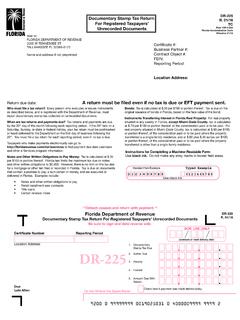Transcription of State income tax apportionment What you need to know now
1 State income tax apportionment What you need to know nowArthur J. Parham, Service A. WethekamHorwood Marcus & CoveDeloitte Tax 2016 The National Multistate Tax Symposium: February 3-5, 2016 Trends in State income tax apportionment Factor presence nexus and single sales Cost of performance updates Multistate Tax Commission rewrite Throwback and throw-outAlternative apportionment and Multistate Tax Commission litigation update Alternative apportionment Multistate Tax CommissionlitigationApplying market-based sourcing Analysis of revenue stream Lack of consistency in market definitions Data solutions AgendaTrends in State income tax apportionment3 Copyright 2016 The National Multistate Tax Symposium.
2 February 3-5, 2016 Factor presence nexus standards States are more heavily weighting sales factors as well as moving to 100% sales factors Significant focus from states on cost of performance rules and ongoing litigation For sales factor sourcing, the trend is that states are moving towards market-sourcing rulesApportionment emerging trends4 Copyright 2016 The National Multistate Tax Symposium: February 3-5, 2016 Sales factor considerationsSales of non-TPPCost of performance MarketProportional/Time spentSales of TPPD estinationUltimate destinationDock5 Copyright 2016 The National Multistate Tax Symposium: February 3-5, 2016 Sales ofnon-TPPCost of performanceTransactionalOperationalTime spentMarketCost of Performance Update6 Copyright 2016 The National Multistate Tax Symposium: February 3-5, 2016 Considerations for throwback and throw-out rules: Foreign sales transactions Nexus standards Origination determinations revenue stream treatmentSales throwback and throw-out rules7 Copyright 2016 The National Multistate Tax Symposium: February 3-5, 2016 In light of the overwhelming lack of uniformity among the states, the Multistate Tax Commission (MTC) approved a public hearing to review five provisions of UDITPA.
3 Sales factor numerator for sourcing services and intangibles The definition of sales Factor weighting The definition of business income Equitable apportionmentUpdate on proposed UDITPA rewrite8 Copyright 2016 The National Multistate Tax Symposium: February 3-5, 2016 March 2014: MTC Uniformity Committee (Uniformity Committee) sends its original five recommendations from December back to the Executive Committee December 2014: The MTC s Uniformity Committee on December 11 voted to instruct the work group charged with designing market-based sourcing model regulations to use as its starting draft the package of rules proposed in Massachusetts. December 2015: The Multistate Tax Commission's Uniformity Committee on December 10 approved draft market-based sourcing model rules and definitions for Executive Committee consideration, then formed a work group to address alternative apportionment issues identified during the drafting process.
4 Update on proposed UDITPA rewrite for salesAlternative apportionment and Multistate Tax Commission10 Copyright 2016 The National Multistate Tax Symposium: February 3-5, 2016 If the allocation and apportionment provisions of this Act do not fairly represent the extent of the taxpayer s business activity in this State , the taxpayer may petition for or the [tax administrator] may require, in respect to all or any part of the taxpayer s business activity, if reasonable: Separate accounting Identifying the income and expenses earned in a specific jurisdiction. Exclude a factor A factor is not material to the income producing elements of the taxpayer s business or the existence of the factor is negligible.
5 Add a factor The additional factor is representative of the activity that generates the income ( , extraction factor). Other Combined returns. Intangible property included in the property factor. UDITPA 1811 Copyright 2016 The National Multistate Tax Symposium: February 3-5, 2016 Who may invoke alternative apportionment ? The taxing jurisdiction may require the use of an alternative apportionment method. A taxpayer may petition for the use of an alternative apportionment method. Generally, the request must be made in advance of filing the original 1812 Copyright 2016 The National Multistate Tax Symposium: February 3-5, 2016 Burden of proof Level of proof The burden of proof in most civil cases is the preponderance of the evidence.
6 Requires only slightly more evidence in support of a proposition than against it 51% Some tax cases require clear and convincing highly probable 75%-80% Which party has the burden? Generally the burden of proof is on the party attempting to deviate from the plain reading of the statute. Is there a different standard depending on which party seeks the alternative method? What, if any, impact does the deemed correctness of an assessment have on the burden of proof?UDITPA 1813 Copyright 2016 The National Multistate Tax Symposium: February 3-5, 2016 Burden of proof: First prong: Prove that statutory method is distortive Distortion standard is not the constitutional Due Process distortion standard ( , Hans Rees250%) Must the entire formula be distortive or only an individual factor or factors?
7 Show that standard method of apportionment fails to fairly represent taxpayer s in- State business activity Is this a savings clause used to prove a fair result where the standard formula may not result in a constitutional violation?UDITPA 1814 Copyright 2016 The National Multistate Tax Symposium: February 3-5, 2016 What is the standard of proof? Unconstitutional result Twentieth Century Fox v. Oregon department of revenue , 299 Ore. 220 (1985).The Oregon Supreme Court held alternative formula is only applicable to remedy unconstitutional situations or where the UDITPA formula does not fairly represent the business activity of the taxpayer . apportionment method is appropriate: Kennecott Copper v.
8 State Tax Commission, 493 632. The Utah Supreme Court did not rely on any standard but merely concluded the statute allowed the use of an alternative 1815 Copyright 2016 The National Multistate Tax Symposium: February 3-5, 2016 Which party bears the burden of proof? State requires the use of an alternative formula: Prima facie correctness Shifts the burden Indiana department of revenue v. Rent-A-Center East Inc., 963 2d 463. Equifax and Equifax Credit Information Services, Inc. v. Ms. department of revenue , MS (June 20, 2013), Pet. for Cert. denied Bell South Adv. & Publishing v. Chumley, 308 So. 3rd 350(TN App. Ct.).UDITPA 1816 Copyright 2016 The National Multistate Tax Symposium: February 3-5, 2016 Due to the adoption of a single sales factor by a number of states, the option to use the standard 3-factor apportionment formula in such states becomes an attractive alternative method for out-of- State taxpayers.
9 May a taxpayer elect to use the standard 3-factor formula under MTC Compact Articles III and IV? Is the election the use of an alternative formula?Multistate Tax Compact ElectionApplying market-based sourcing18 Copyright 2016 The National Multistate Tax Symposium: February 3-5, 2016 Sales ofnon-TPPCost of performanceTransactionalOperationalTime spentMarketBenefit isreceivedWhere deliveredWhere customeris locatedWhere usedSales of non-TPP considerations Applying market-based sourcing19 Copyright 2016 The National Multistate Tax Symposium: February 3-5, 2016 Approximately two dozen states have currently adopted market-based sourcing rules for sales other than of tangible personal property.
10 States that have recently transitioned to market-based rules include: Arizona (elective phase-in 2014-2017) California (elective in 2011 and 2012, mandatory as of 2013) District of Columbia (2015) Massachusetts (2014) Missouri (effective August 28, 2015) Nebraska (2014) New York State (2015) New York City (2015) Pennsylvania (2014) Rhode Island (2015) Tennessee (July 1, 2016)Adoption of market-based sourcing1920 Copyright 2016 The National Multistate Tax Symposium: February 3-5, 2016 There are a number of theories that have evolved from the adoption of amarket-based approach: Delivery generally defaults to the customer or other delivery location Receipt of service does this differ from delivery?



















